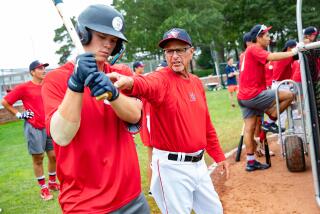Picking Up a Natural Habit
- Share via
Peeling the label off a sweaty, empty beer bottle mesmerizes my 2-year-old for as long as 10 minutes. The stripped bottle leaves him most satisfied, inspiring an audible sigh.
I ask him why he does it.
“Because I have to ,” he says.
My husband says the same thing when I complain about his ritual heel picking. There is dead skin, he argues, I have to get rid of it.
Even at age 2, the compulsion to pick and peel things can be overwhelming, whether it’s loosened labels, curling paint, flapping hangnails or sunburned skin (a personal favorite). To pick is to cast off what shouldn’t be there, to rid the world of imperfections.
The behavioral tic is a fairly benign human grooming behavior, except in obsessive compulsive cases where the urge is too powerful to resist. It is thought to be caused by a combination of genetic encoding and learned behavior, say scientists and psychologists.
“If it is not an inborn behavior, it is one that people have a lot of susceptibility to,” says Dr. David Hellerstein, the physician in charge of psychiatric outpatient services at Beth Israel Medical Center in Manhattan. “It is related to grooming and feeding activity. Animals will pull bark off trees for food. Pulling scabs off is part of getting something off of you that does not belong.”
Picking a stray hair, crumbs or cat fur off clothes or furniture is not something we do only to ourselves. Some people say they find picking fleas off their dogs or cats profoundly satisfying, second only to good sex. You see the dirty bloodsucker, one pick, a quick decapitation and you have improved a life. It’s instant gratification.
Close gal pals hold grooming watch over each other, plucking wayward hairs off shoulders, pointing out pepper in teeth and tucking in flapping yokes. This social practice is most handy when that humiliating skirt-tucked-into-tights-thing happens as we exit restrooms.
But for some people, the internal pressure to pick kicks in even around strangers.
“I feel the urge especially with respect to things on other people,” says Donald Symons, an evolutionary psychologist at UC Santa Barbara and author of “Evolution of Human Sexuality” (Oxford University Press, 1979). “I’ll be in line at the grocery store and I’ll see a person in front of me with lint on him and I can feel so strongly the urge to pull off the lint. I’ll actually try to think of a way to do without them noticing.”
Our closest relatives in the animal world, nonhuman primates, are pal pickers extraordinaire. Grooming each other is part of a highly social activity that is hygienic and offers social reassurance.
“Chimps who are allies or friends will groom each other,” says Craig Stanford, USC assistant professor of anthropology who has extensively studied social behavior of chimpanzees. “Animals after conflict will groom to reconcile. Low-status animals suck up by grooming other animals. There is also a level of excited grooming where their lips smack when they really get into it.”
Stanford says that the behavior is universal among social beings. While in India with his wife, Erin Moore, a UCLA cultural anthropologist, he observed reciprocal grooming, a bonding ritual not unlike the kaffeeklatsch.
“Women would stand around and go through each other’s hair with their fingers looking for lice and they were talking and laughing,” Stanford says. “It was a real social thing.”
*
But picking at things is more than the functional equivalent of grooming ourselves and our environment. The behavior also offers a real psychological payoff.
Exploiting the picking tic are companies that sell children’s stickers and sticker books. Many children go ballistic unless they can pull off every single one. Some cosmetic companies are milking this urge, selling peel-off face masks and nail polishes that seem to have a time-released peel mechanism. It takes a bigger woman than me to leave chipped lacquer on the nail without going into a picking frenzy. And, of course, once you’ve purged the imperfect stuff from your nail, you have to apply another coat. World without end, amen.
Meanwhile, back at the Hofbrau haus, Christmas brew is stocked for the festivities. And, I may be imagining it, but I think my son has some of kind of conditioned response at the sight of a beer bottle: fingers tense and face sets in concentration. At any rate, I’ll take this as a positive sign.
According to Sharon Lamb, an assistant professor of psychology at Bryn Mawr College, when children exhibit the urge to pick at something imperfect or inconsistent with a surface, a swollen mosquito bite or chipped paint, it marks the beginning of their ability to distinguish between what is and what ought to be.
So, in the name of my child’s moral development and until he moves onto the more mature pastime of heel picking, cheers.
More to Read
Eat your way across L.A.
Get our weekly Tasting Notes newsletter for reviews, news and more.
You may occasionally receive promotional content from the Los Angeles Times.










